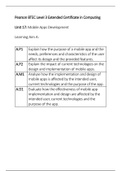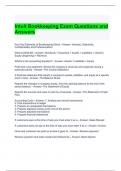Summary
Summary Learning Aim A | Unit 17 - Mobile Apps Development | BTEC Computing | 2020
- Institution
- PEARSON (PEARSON)
A.P1 Explain how the purpose of a mobile app and the needs, preferences and characteristics of the user affect its design and the provided features. A.P2 Explain the impact of current technologies on the design and implementation of mobile apps. A.M1 Analyse how the implementation and design of m...
[Show more]




